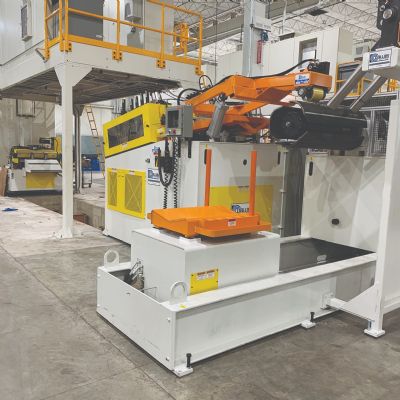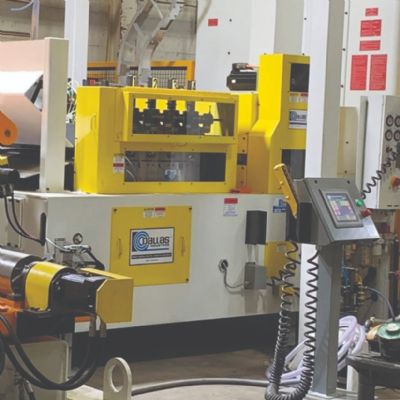Move Profiles
With continued advances in servo-control technology, servo-driven roll feeds now feature a variety of move profiles to further optimize certain feeding applications. These move profiles include trapezoid-shaped, s-curve shaped and press-profile feeding.
The trapezoid-shaped profile—most commonly used—meets most application requirements and can deliver high-performance output. However, it comes with the trade-off of sharp velocity transitions, called “jerk points.” These jerk points occur at the beginning, middle and end of each index of the coil strip as the feed transitions between the acceleration, velocity and deceleration portions of its move profile. This can cause slight witness marks on the material, unacceptable in some cosmetic nonmarking applications.
To avoid witness marking, metalformers can use s-curve acceleration move profiles. Here, the feed makes gradual transitions in velocity, with high acceleration and deceleration in the interim. This profile avoids jerk points and the increased potential for material damage.
Press-profile feeds are electronically geared to the press so that the feeder acceleration and velocity follow the press as it quickens or slows. These feeds require an additional feedback device, such as an encoder or resolver, mounted to the press crank to monitor press rotation and speed.
No Discussion of Press Feeding Would be Complete
…without mentioning pilot release— the act of momentarily releasing the strip so it can be aligned by the pilot pins in a progressive or blanking die. The pilot pins correct for slight misfeeds by pulling the material into final position for forming or blanking. This momentary release helps to relieve built-up stress and binding of the strip through the feed and die due to misalignment or camber. It also alleviates potential “walking” problems of the coil strip as it moves through the die.
Most servo-driven roll feeds include an air-operated pilot-release mechanism. To optimize pilot-release timing and performance, also select a mechanism with adjustable stroke. Correct timing of the roll opening and closing is critical to a successful pilot release—made easier if it’s easily adjusted for each tool.
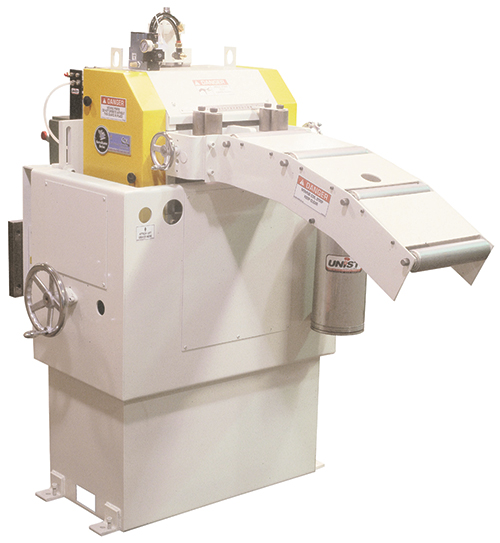
Servo feed with cabinet and self-centering edge guides.
Modern press controls typically use programmable cams to optimize the feed window and the pilot-release window for each die. Air-operated pilot-release mechanisms have a limited speed capability, although some units can attain speeds to 300 strokes/min. Some manufacturers offer servo-driven pilot release, an expensive feature but one that offers the advantage of being completely programmable and capable of very high speeds.
Mounting Options
Other basic considerations for any press-feeding application include the servo-feed mounting method, the material support system and the material guiding mechanism. These all contribute to the overall capability and effectiveness of the press-feeding system.
The three most common mounting methods for a servo roll feed are fixed-press mounting, adjustable-height mounting brackets, and floor-standing machine cabinets. For smaller servo feeds and more dedicated feeding applications, metalformers typically opt for fixed-press mounting—the most economical and practical solution. Here the feed bolts directly to the press; passline-height adjustment must be done after manually unbolting the machine and supporting the weight of the servo feed.
Press-mounted adjustable-height brackets offer the same floorspace savings, while also providing support of the servo feed—stampers adjust passline height with a hydraulic or screw jack, no tools required. Lastly, floor-standing machine cabinets typically find use for larger machines or for applications requiring ancillary equipment such as shears, oilers, or material-support tables to be mounted to the servo feed. Cabinets typically are provided with motorized passline-height adjustment and no-tool press-mounts.
Material Support and Guidance
The catenary section is the mechanism used to support the continuous coil as it enters the servo roll feed. In conventional coil lines where the material is straightened ahead of the servo feed, the catenary section must be designed to properly support the strip as it draws from the slack loop. Lacking the necessary radius and arc of support will increase the potential to re-induce coilset or damage the material. Blanking operations, as well as certain progressive-die applications that require the incoming coil strip to be flat, can be compromised by inadequate catenary-section design.
Responsibility for material guiding in most servo roll feeds falls to the edge guide, which must maintain the continuous coil strip on center and square to the feed rolls and die. Any misalignment of the strip to the feed rolls will result in tracking of the strip relative to the main axis of the feed rolls. Likewise, any misalignment of the strip to the die will increase the potential for short feed lengths and mishits.
Like the other servo-feed devices, a variety of edge guides are available to meet the application and budget requirements for each job. Manually adjusted edge guides suit simple and dedicated feed setups; handcrank-adjusted edge guides find use for lines that require frequent changes in material width; and motorized and encoded edge guides often are used to free the operator from having to make these adjustments for each setup. MFView Glossary of Metalforming Terms
See also: Coe Press Equipment Corporation
Technologies: Coil and Sheet Handling, Pressroom Automation







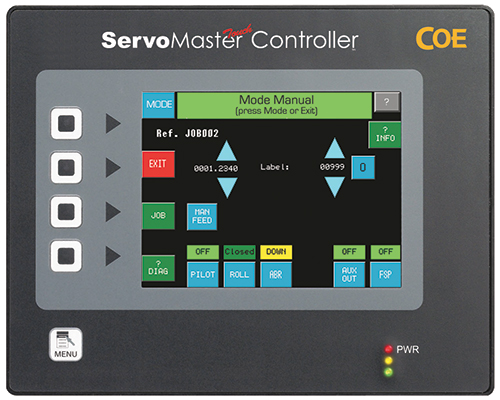
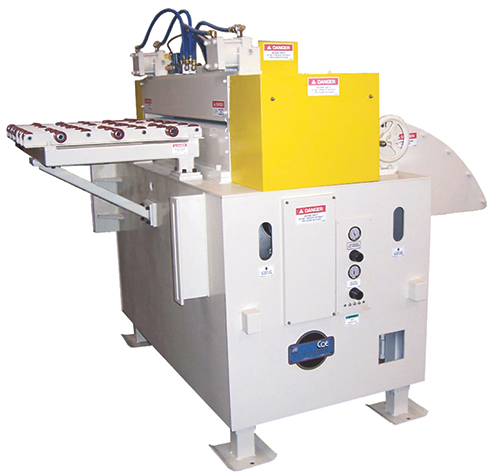

 Video
Video